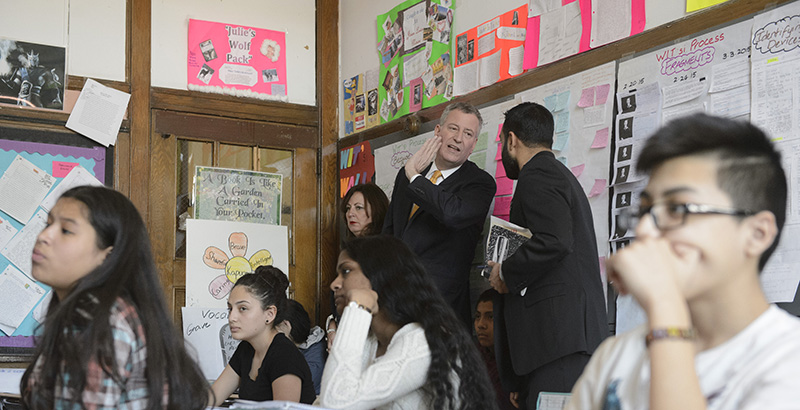NYC Teachers Who Lost Their Jobs but Remain on the Payroll Receive Big Raises as Budget Watchdogs Call to Reform $136M Absent Teacher Reserve

A problem that has vexed New York City for years emerged again this week with news that educators who lost their positions but remain on payroll will receive average salary increases of more than 19 percent next week, bringing the cost of paying them this year to $136 million.
The raises go to all teachers, but they will be disproportionately large for those in the Absent Teacher Reserve — a pool of tenured teachers and school staff displaced by budget cuts, school closures, or discipline infractions. Although they are no longer in permanent jobs, they tend to have more seniority, which entitles them to larger compensation bumps.
The Citizens Budget Commission, a watchdog group that published a report on ATR spending this week, hopes its tally of rising costs will add pressure to the city as it turns to negotiate a new teachers contract in the fall. The group’s report urges Mayor Bill de Blasio to find a cheaper solution to a challenge facing school districts across the country: how to ensure that principals aren’t forced to accept teachers simply because they have more experience.
“By offering full pay, raises, step increases, and longevity increases, the ATR provides no incentive for unmotivated or unsuitable teachers to secure new permanent placements,” the report says. “The ATR should be a temporary stop, not an unlimited job guarantee.”
On average, the budget group reports, a teacher in the ATR has worked in city schools for 18 years and earns $98,126 annually. The average for all city teachers is 10.2 years and $84,108. On Monday, the salary of an 18-year veteran will go up by $16,210.
The size of the ATR waxes and wanes during the year as teachers come in and, after getting re-hired, go out, but it’s typically larger in the fall. There were 1,202 employees in the reserve at the start of this school year, and 756 in April, according to the CBC. Those numbers were lower than in 2016-17, when the ATR had 1,304 employees in October 2016 and 822 by last July and cost the city $152 million, according to a separate analysis.
The Department of Education has had mixed success using different approaches to curb costs. Nearly 300 employees took buyouts offered in 2014 and 2018. A program that subsidized the salaries of ATR teachers helped move 372 of them into schools last year. But a controversial plan announced last summer to place about 400 teachers from the pool into permanent positions without the approval of principals has sputtered.
As of February, only 75 had been placed, saving $7 million, the CBC says, a result likely to frustrate both city administrators and those who view the policy as a return to the era of forced placement, which the ATR was designed to remedy.
The DOE disputes that figure, saying it has not updated totals since December, when it reported that only 41 teachers had been put into schools. Ana Champeny, the report’s author, said its numbers come from the city’s Office of Management and Budget and were discussed with the DOE.
“We’ve made common-sense reforms to the Absent Teacher Reserve, cut the pool down by 450 teachers in two years and are on track to reduce the pool by half for next year,” DOE spokesman Will Mantell said in a statement. “Under this administration, we’ve helped 2,300 educators leave the profession. On the first day of school this year, the ATR pool was down 20 percent from the start of the 2016-17 school year, and 39 percent from the start of the 2013-14 school year.”
The ATR was created by the Bloomberg administration during collective bargaining in 2005 as an effort to move from a seniority-based teacher placement model to one governed by “mutual consent,” which gave principals hiring ability and teachers the right to refuse placements they didn’t want.
“We expected that a reserve pool would result, but thought it was a worthwhile cost of giving principals the ability to hire their teams,” said Daniel Weisberg, who helped negotiate the agreement for the city with former United Federation of Teachers president Randi Weingarten.
“I wouldn’t have been surprised,” Weisberg said, if he’d been told then of the long-run costs, but acknowledged he would be “disappointed that we weren’t able to finish the job of creating a sustainable mutual consent system whereby ATRs would have a reasonable limit on their ability to remain in the pool.”
Weisberg is currently the CEO of TNTP, a teacher training and advocacy organization that published findings in 2014 indicating more than half of those in the ATR hadn’t applied for a job in the previous year, about one-quarter had faced disciplinary charges, and one-third had received unsatisfactory ratings.
Despite such characterizations, the UFT argued that teachers in the ATR have helped defray large costs. “Thousands of teachers go on leave every year for medical and other reasons,” said Dick Riley, a union spokesman. “If the DOE had to hire substitutes to cover all of these, the cost could be as high as $1,000 per week per sub. ATRs are already on the payroll.”
New York City remains nearly alone in its ability to work around forced placement. Most districts continue to sanction some form of seniority-based hiring, which is usually enshrined in state law. Few if any large districts have the resources to absorb the cost associated with unattached teachers, and unions are unlikely to negotiate away members.
That position may become even more inflexible if, as expected, the Supreme Court rules this month for the plaintiff in the Janus case, which challenges the constitutionality of fees charged by unions to non-members and could spark an exodus of members and millions in lost revenue.
Kate Walsh, president of the National Council on Teacher Quality, says few states or districts have seriously considered making changes to the way teachers are hired since President Obama spurred educational innovation during his second term. “Nothing’s changed. There’s been almost no activity since the big round under Race to the Top, when there was a lot of movement between 2010 and 2013 in states hoping to do something. It’s extremely hard to do.”
Among those states, Colorado changed its laws in 2010, discontinuing forced placement and giving excessed teachers a year to be rehired or be put on unpaid leave. Chicago and Washington, D.C., also ended seniority rights. Los Angeles just decided to allow its most struggling schools to fill vacancies as they choose.
Upcoming negotiations
New York City’s churning economy gives the UFT and other unions a strong position in upcoming bargaining sessions. Meaningful changes to the ATR will require significant givebacks, which may not be possible.
“It’s really The Art of the Deal,” said Maria Doulis of the Citizens Budget Commission, citing the famous volume by President Donald Trump. “It’s really how high a priority it is for the city: $136 million.”
If teachers in the ATR were given a deadline of six months to be rehired, she said, “that concession could pay for paid parental leave. It’s about how high the priority is.”
The UFT hopes to win paid leave for its members this fall and has fallen out with the mayor over the issue.
Ian Rosenblum, executive director of The Education Trust–New York, which found that the city placed ATR teachers in low-performing schools, said, “What the city should be thinking about is the opportunity costs of that $136 million and how those resources could be spent to help students. The ATR question is about providing access to good teachers for the students who most need it.”
Help fund stories like this. Donate now!

;)
